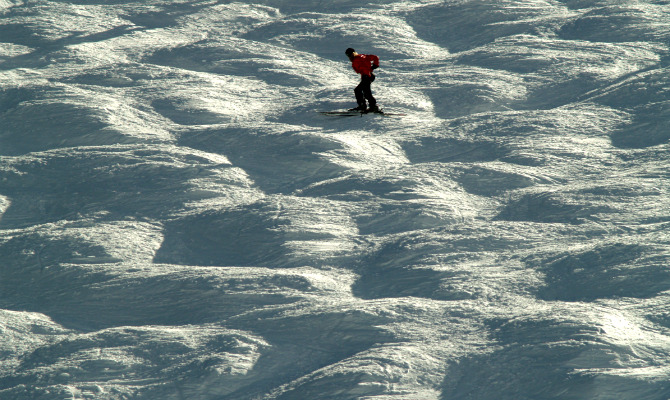Tips: How To Get Better At Mogul Skiing
Mogul skiing is not recommended for beginners. The slopes with artificial bumps are usually the least crowded runs which makes them very attractive. The bumps bring out different emotions in skiers ranging from fright to excitement.
Mastering them takes a lot of practice and some falls, but this kind of skiing is one of the most rewarding because it's a lot more challenging. The moguls actually make you a better skier in the long run because they help you control your speed. Eventually you feel a lot more comfortable going down steeper slopes.
So, look at the bumps, smile and get ready to conquer them. Before you get on your ski, however, it's good to do a few exercises that can help you prepare for the task ahead. "The best thing you can do is box jumps," Andrew Barfield, a skier with more than 20 years of experience and director of snow sports at Snow Basin, says. "That's because your legs constantly get long and short" in both box jumping and mogul skiing." The challenge, also in both, is to maintain balance.
"You should never ski moguls if you can't make short and round turns in ground runs," Barfield says. The first step of getting ready for the bumps is getting comfortable on easier slopes. Get the hang of them before you go to more advanced terrains. Loose the poles for a few feet drills.
You're going to need the poles on the bumps run. They help anchor the upper body, Barfield says. "They are the third point of balance," he adds, because they are contacting the ground. Start on small bumps to get a sense of how your body should move. Always keep your poles in front where you can see them. They should be moving with your turns. If you're going to do a "pole plant," you must do it on top of the mogul to stay balanced.
The most common error skiers make is looking at their feet. Your head should be facing forward, not down. "Ideally, you should look at 3-4 bumps ahead of you. Don't be scared. You are out of balance to begin with if you are looking down. You have no time to fix your stance because moguls come at you quick. Your legs are constantly going up and down.
To help you better understand how you should move around the mogul, Barfield says, imagine you stand on top of a bump and dump a bucket of water. Wherever the water flows, that's where you should ski. "Visualize the line if you don't know where to turn."
Turns are another part of mogul skiing people often do wrong. "They will get down between the bumps and twist the skis there," Barfield says. This is wrong; don't ever do it. The proper way is turning with the tail of the ski when you're on the shoulder of the mogul. You have to control your speed very carefully when skiing on the bumpy slopes. Side slips and hockey stops are the way to do it when you start. Ski at comfort level before you try and impress the rest of the skiers with how fast you can go.
"Moguls are like driving in a rugged road," Barfield says. "Snow is pushing on you and changes come quick." The difference is the bump skiing is not unpredictable. This kind of skiing is more challenging but not too difficult. It's not even bad for your knees (contrary to popular belief).
"Bump skiing doesn't have to be tiring," Barfield adds. "It gets like that for some people because they don't get their legs long." You should do that when you go down off the bump. "Your legs are most flexed when you're on top of the bump," he says, so you use the other time to extend and relax them.
You can avoid knee pain by properly absorbing the moguls with your legs. Use them to absorb the shock of coming into a bump. As you get on it, flex your knees and ankles. Your upper body should stay upright and in balance. The legs should be flexed up usually to the height of the bump. Then, as you go down, release and push out your legs. Practice the absorbing movement with compression turns.
More readings:
Best New Skis and Boots for 2016
